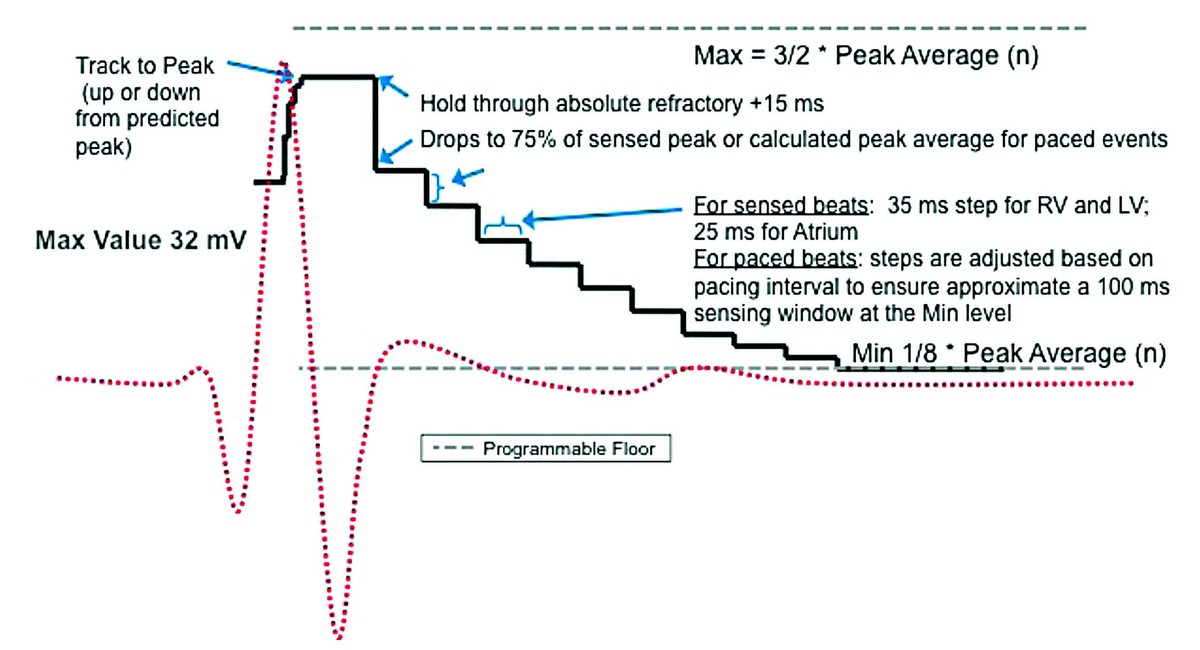Sensing arrhythmias in Boston Sctientific ICDs
Sensitivty
The reliable function of a defibrillator mandates a flawless detection of the rapid, low-amplitude signals associated with ventricular fibrillation (VF), while rejecting the cardiac signals besides the QRS as well as all extra-cardiac signals. This implies the programming of a high sensitivity and short refractory periods. Unlike in cardiac pacemakers, the sensing threshold, instead of being a fixed programmed value, is automatically adapted to the amplitude of the preceding R wave. Thereafter, the sensitivity increases throughout the cardiac cycle, in search of a low-amplitude signal. Defibrillators are equipped with a digital automatic gain control (AGC) in charge of dynamically adjusting the atrial and ventricular sensitivity. In triple chamber defibrillators, the atrial, right ventricular (RV), and left ventricular (LV) channels each operate with a separate automatic AGC. Atrial AGC is nominally 0.25 mV; Right Ventricular ACG is nominally 0.60 mV; Left Ventricular AGC is nominally 1.0 mV.
The programmable settings are 0.15, 0.2, 0.25, 0.3, 0.4, 0.5, 0.6, 0.7, 0.8, 0.9, 1.0, 1.5 mV.
Before their measurement, the signals are filtered according to their frequencies. The latest generation of Boston Scientific defibrillators use a bandwidth between 20 and 85 Hz (the frequency of a T wave is typically between 0 and 10 Hz). The electrical signal is converted to a numerical value by a 12-bit converter.
Automatic gain control
To optimize the sensing of the rapid and irregular signals associated with VF, the device adjusts the ventricular sensitivity according to a slow or fast AGC. The AGC applies a “slow” component to set an interval in search of the next QRS amplitude. By calculating an “average” of the peaks of the preceding signals, the “slow” component defines a zone that is likely to contain the following peak, and sets this zone between a minimum and a maximum value.
Average Peak (n) = 3/4 * Average Peak (n-1) + 1/4 * Peak (n-1)
If n-1 was paced → Peak (n-1) = 8 * programmed AGC threshold
Maximum (n) = 3/2 * Average Peak (n)
Minimum (n) = 1/8 * Average Peak (n)
The “rapid” component of the AGC maintains a high sensitivity value after sensing a ventricular event, before gradually decrementing the sensitivity setting in order to increase the device’s sensitivity. After sensing of a ventricular signal there is a RV sense refractory period non programmable of 135 ms (50 ms absolute blanking + 40 ms noise + 45 ms fixed refractory). At the end of the refractory period + 15 ms, the sensitivity setting decreases to 75% of the sensed peak or, if the last ventricular event is paced, to 75% of the average peak. Importantly, full R-wave range is available up to 32 mV. The AGC thereafter decreases the sensitivity setting every 35 ms, to 7/8 of the previous setting. This decremental process continues until the highest value between the minimum and the programmed sensitivity setting. If the last ventricular event is paced, the AGC decreases the setting to 7/8 of the preceding value with each following step, though the step duration is determined by the minimum pacing rate: the Min value (or the programmed sensitivity setting) is reached 150 ms before the next programmed paced event.




